#001 — the archivist’s writings.
Text


SUBJECTS: mondstadt boys, genshin impact.
TYPE: comfort, fluff.
CATEGORIZATIONS: gender neutral reader, physical touch (hugging, hand holding, mild kissing but not on the lips, etc,) sharing a bed, potential romantic undertones, unspecified nightmare, extremely brief violence (bennett hits you to wake you up lol).
ARCHIVIST’S NOTES: you wake up from a nightmare. luckily, someone is there to comfort you.


after perhaps the fourth or fifth repetition of your name, your eyes snap open, and you stare blankly at albedo. he stares back, brows creased with concern. “can i touch you?” he whispers, barely audible. you manage a nod, and he very carefully takes your hand. you inhale slowly, trying to match the rhythm of his breathing. albedo handles you like glass, merely sitting beside you for a moment. he asks, “do you want to talk about it?” and you merely shake your head. “alright. i’m here for you.” you give him a small smile, and lift your interlocked hands to your lips, pressing a kiss to his knuckles. “i know,” you murmur.


in your defense, you were only acting accordingly. when someone slaps you in the face, even in the throes of a nightmare or the embrace of sleep, it’s only natural for you to respond in turn. so that’s how you wake up already mid-slap, bennett looking at you with wild eyes. you wrench your hand back as if it’s been burned, and bennett grins, apparently unconcerned by the fact that you were about to hit him. “sorry,” you say, more than a little alarmed. “are you okay?” bennett asks earnestly, taking both your hands in his. “do you need anything? water, warm milk, tea—”?” “no, bennett, i-i’m fine. just…” you squeeze his hands, offering a smile. “just you.”


it takes you a while to come to, but once you do, with heaving chest and pounding heart, you’re enveloped in a warm embrace. diluc is never the touchy-feely type, not like you are, but he makes exceptions. you swallow thickly, turning to look at him. his eyes are shut firmly, though the speed of his breathing indicates he’s very much awake. wrapped in his strong arms, it’s hard to remember what you were so scared of in the first place. with a soft exhale, your eyes drift off, and you let sleep take you once more.


you tear your eyes open with a shudder, the vestiges of your dream already fading like fog in the morning sun. you stare at the ceiling blankly, trying to gather your thoughts, and suddenly feel an ice-cold touch on the back of your neck. your whole body crumples in a flinch, and you grumble, “kaeya!” a soft laugh is the only reply you earn, an arm wrapping around your waist. “sorry,” he murmurs, not sounding even remotely so. “what were you dreaming about?” and oddly enough, you don’t even remember.


razor likes to sleep in piles, so it’s not alarming when you wake up to him all curled up, practically lying on your chest. you clear your throat, wriggling away from him if only so you can breathe, and razor barely seems to stir as he wraps an arm around you, holding you in place. you let out a sigh, wrapping an arm around him in turn. you can feel his heartbeat where your chests connect, steady and even. you listen to it for a moment, waiting for the pounding of yours to slow, and razor opens one eye to peer at you. when you look back, he closes it quickly, feigning sleep. you can’t help but smile and reach up to ruffle his hair, letting out a slow breath. you can’t even remember why you woke in the first place.


neither of you are strangers to nightmares. it’s a good day when neither of you has one, but a rare one. you’re unsurprised when you wake up covered in sweat, a dying scream pulling at your vocal chords. venti barely seems to have noticed, but the way that he’s wrapped around you like a cocoon indicates otherwise. you wince, rubbing your eyes wearily. “sorry,” you whisper, voice hoarse. “don’t be,” venti replies. you let out a slow breath, releasing all the air from your lungs, and listen to the sound of his heartbeat, and the soft hum of a long-forgotten hymn upon his lips.

#001 — the archivist’s writings.#albedo x reader#genshin albedo x reader#bennett x reader#genshin bennett x reader#diluc x reader#genshin diluc x reader#kaeya x reader#genshin kaeya x reader#razor x reader#genshin razor x reader#venti x reader#genshin venti x reader#genshin#genshin impact#genshin imagine#genshin headcanons#nightmare comfort#comfort#fluff
210 notes
·
View notes
Note
hello! I hope you’re doing well! I’m here to gush a bit about how hyped up your TMA/QSMP au has got me. I’m losing my mind in the best way possible, especially about Jaiden’s alignment with the End- I feel like her story especially was so so clever. do you have any other headcanons you’d like to share, or character alignments? I totally get if not (for the sake of not spoiling future fics) but I just wanted to let you know your fics are 10/10 and I’m full of thoughts about them
(So, I'm finally at my keyboard and can type this all out.)
First, the stuff that doesn't contain spoilers. All my fics for statements 001 to 005 are written along with one or two oddballs for after that. I also have ideas for a few more than that. I am posting them out of order to try and give the TMA vibes of the statements not being listened to in order by the reader that they were recorded. (I don't know if I'll be able to keep it up forever, but I want to try to keep them out of order.)
There isn't exactly an overarching plot to the series as of right now and I don't know if there ever will be (Other than Cellbit becoming more entangled with The Eye). I also don't have a fic that is going to be the final fic of the series. It might be a series that I just randomly write for and then one day stop. (I am also open to ideas from people about characters and entity interactions that they would want to see but no promises that I'd write anything.)
Whenever I want to post a new one, I ask my brother to give me a number and then I post that fic. It's also something I just randomly when I want to write but don't want to work on my like bigger fics (The Android AU, The Ghost Rom-Com, or The Hunger Games Inspired AU).
(Spoilers lie under the read more.)
Headcanons/Fun Facts:
Any statement Cellbit makes while Roier is around never goes correctly, he always misses some part of it. (Like how in Statement 002- Itsy Bitsy Spider Cellbit doesn't say "End Statement.")
Cellbit is aligned with The Eye, but he is not the archivist because I can't see him having a more structured job like being the archivist would kind of entail.
The only reason Roier wasn't killed with his friends is the fact that he hasn't killed any of the spiders and because of that The Web grew fond of him and gives him gifts.
Jaiden's thing with The End was just kind of me being like what is the worst entity that Jaiden could come in contact with, and I was looking over the entities and saw that The End can affect dreams and I just got the idea of the bird bones. (After her visit with Cellbit to make her statement, the dreams disappear.)
Jaiden's bird bones are actually from Phil's crows because the crows are more like ghosts than living animals.
The thing that replaced Juanaflippa actually doesn't plan to hurt Charlie, she just wants his love.
Character + Entity Alignments
So Cellbit is obviously aligned with The Eye but in the past, he also had a run in with The Hunt (Which is where like his serial killer past ties in. I have plans to write a fic about that but I'm not entirely sure how or when.)
Roier has his whole thing with The Web but after Cellbit starts his investigation Roier gets contact with some of the others. (It's because of his proximity to Cellbit.)
Wilbur is tied to The Buried. He gets trapped in a train (Think Limbo but without him being replaced by Ghostbur.) but after he gets out he makes a statement with Cellbit and then gets trapped in the train again.
Philza and Missa are both aligned with The End and to each other.
Felps gets taken by The Burried and is like literally buried in a cementary and Cellbit has to find him but since I'm not confident in how Felps talks and like how he acts I don't know if or when I'll write that fic.
#literally feel free to ask me about any of my fics theres so much to all of them#even the posted ones have little facts that i never flushed out in them for like it not being important#i hope yall enjoy hearing about the tma au#william whispers
6 notes
·
View notes
Text

‘ try to ignore the peanut gallery over there. they never seem to be able to be able to KEEP IT DOWN! ‘ the man’s voice jumped an octave above his usual falsetto as he gestured to the invisible AUDIENCE with an accusatory point of his finger before continuing his oddly jerky gait to his chair. of course, his pointed look disappeared as soon as he turned back to his guest star with a polished, professional smile. ‘ i’m always glad to talk with a fan. though you do look a little young to have been around when my show originally aired... the tapes are pretty popular though! thank gosh for the advent of home entertainment. ‘
@augureddepth / starter call.
#i'm trying to figure out how to write him so i apologize for giving you the weird tma oc#archivist; haven't you learned anything this week? this season? / meriwether s. ic#archivist; haven't you learned anything this week? this season? / meriwether s. v.001#augureddepth
1 note
·
View note
Text
Public Opinion in the JFK Library Archives: School Prayer and the Supreme Court, June 25, 1962
Stacey Chandler, Reference Archivist
In 1958, starting the school day with the Pledge of Allegiance was pretty routine for American kids. But mornings became a bit more complicated that year for students in New Hyde Park, New York, where the local public school board started requiring teachers to lead a class prayer (written by the state’s Board of Regents) after the Pledge each day. It didn’t take long for local dad Steven Engel and a few like-minded parents to challenge School Board President William Vitale on the prayer’s constitutionality, bringing the issue of school-sponsored prayer into the national spotlight and sparking controversy across the political spectrum.
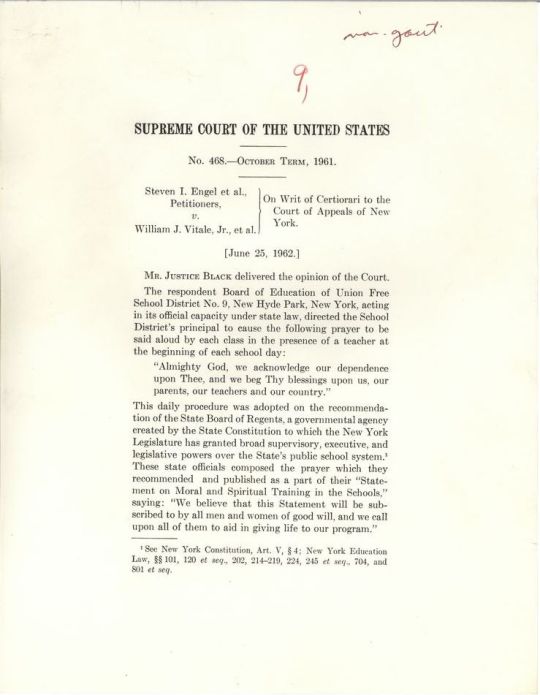
JFKPOF-056a-005-p0025
As Engel v. Vitale made its way through New York’s courts, judges sided with Vitale and school prayer three times, stressing that students could leave the room if they didn’t want to participate. But on June 25, 1962, after hearings at the U.S. Supreme Court, Justice Hugo Black delivered the 6-1 decision that reversed the lower court’s ruling and deemed school-sponsored prayer unconstitutional:
We think that by using its public school system to encourage recitation of the Regents’ prayer, the State of New York has adopted a practice wholly inconsistent with the Establishment Clause. …When the power, prestige and financial support of government is placed behind a particular religious belief, the indirect coercive pressure upon religious minorities to conform to the prevailing officially approved religion is plain.
Though the ruling banned only official school-sponsored prayer and didn’t impact individual students’ rights to pray on school grounds, it motivated people across the United States to write to President John F. Kennedy with their thoughts about the role of prayer in public life. Their letters are now part of the archives at John F. Kennedy Presidential Library, where archivists are working on preserving and describing them.

Damaging materials removed from the Public Opinion Mail collection during preservation.
In the two weeks after the decision, the White House Mail Room saw nearly 1,000 letters on the topic; only 13 of those, a staff member noticed, supported the Supreme Court’s ruling. Most writers brought up Communism or the Soviet Union, echoing the comments of politicians like Alvin O’Konski of Wisconsin, who suggested the Court was “doing everything possible to help Khrushchev bury us.” Meanwhile, children (often writing as part of a Sunday school class) worried they wouldn’t be allowed to pray in school at all.

JFKMPFPOM-1202-001

JFKWHCSF-0886-008
Others attacked the communities associated with the families involved in the case, who identified as atheist, Ethical Culturalist, Jewish, and Unitarian:
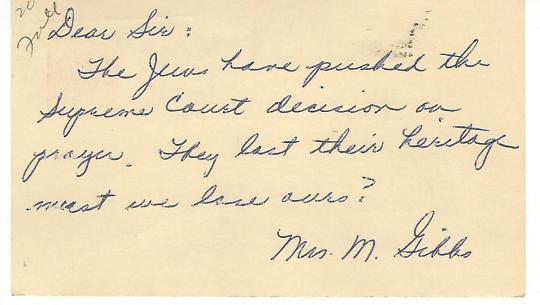
JFKMPFPOM-1202-002

JFKMPFPOM-1202-002
While the letters arrived, JFK was preparing for a previously-scheduled June 27 press conference. Expecting that he’d be asked about Engel v. Vitale, the President’s staff put together a few draft statements, including one that expressed sympathy with the dissenting opinion. But when a reporter asked “Can you give us your opinion of the decision itself?” JFK ditched the prepared remarks and said:
We have in this case a very easy remedy, and that is to pray ourselves. …I would hope that as a result of this decision that all American parents will intensify their efforts at home, and the rest of us will support the Constitution and the responsibility of the Supreme Court in interpreting it.
JFK’s comments sparked a second wave of letters, and most writers expressed concern over what they interpreted as outright support for the Court’s ruling.
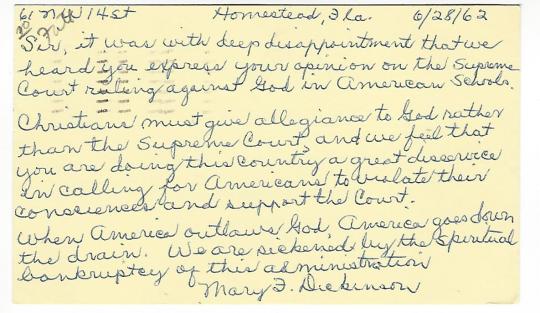
JFKMPFPOM-1202-002
One of these writers was New York fifth-grader Tom Mallon, who later reflected that his own letter “based on a misapprehension (Kennedy was not supporting the Court’s decision per se), shows a stiff anger.”

JFKWHCNF-1709-007
But not all of the letters about JFK’s comments were critical. Scattered throughout the boxes of mail on this topic are letters from leaders of organizations like the American Civil Liberties Union (ACLU) and the United Parents Association of New York City, who wrote in to express their approval of his remarks.

JFKWHCSF-0886-009
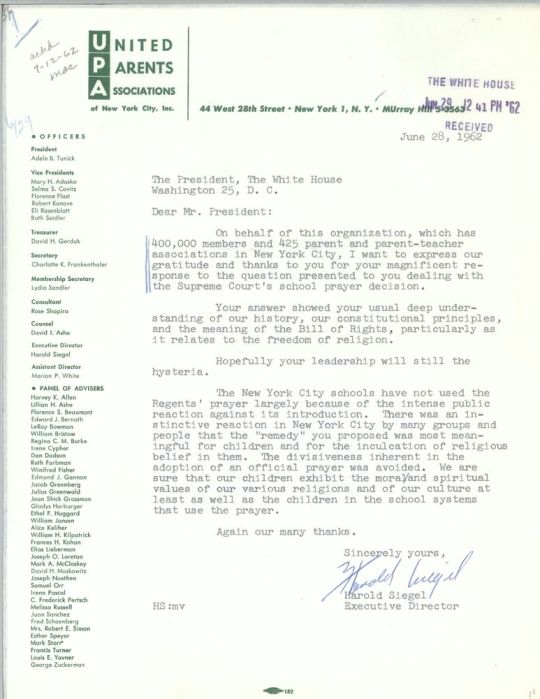
JFKWHCSF-0886-008
By the end of 1962, the flood of White House mail about the case was over – but the controversy wasn’t. In December (after receiving many constituent letters of their own), members of the House of Representatives voted to inscribe “In God We Trust” on the wall in the House Chamber, in what Congressman William Randall of Missouri called “our answer to the recent decision of the U.S. Supreme Court order banning the Regents’ prayer.” But even as the words were mounted on the Chamber wall, another landmark case was on its way to the Supreme Court – Abington School District v. Schempp – that would end Pennsylvania public schools’ required Bible readings in June 1963.
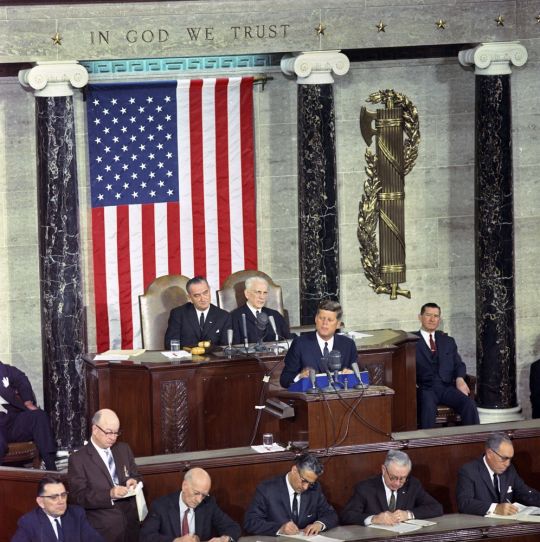
JFKWHP-ST-C7-2-63. John F. Kennedy delivers his State of the Union Address in January 1963 under the newly-installed “In God We Trust” inscription.
While a 1962 Gallup poll tells us that 79% of Americans approved of “religious observances in public schools,” polls can’t always reveal what’s hidden behind the numbers: the beliefs, attitudes, and understandings about an issue that contribute to each person’s opinion of it. Letters from the public can capture the perspectives that raw numbers can miss, and we’re working to preserve these materials for future study of decisions like Engel v. Vitale and their lasting impact on American politics and culture.
36 notes
·
View notes
Text
Excerpt from Only Talking Cat: “How does this happen?”
Overview
In this scene, Alexi has fallen ill from side effects of her time in the research facility. T.S., Malki, and Cass are rushing to find a way to save her. Cass has discovered a dossier of research facility test subjects - including Alexi. Malki becomes distressed by the information. Some of the writing is clipped.
Content Note: discusses the pain Alexi is experiencing as a result of her time confined in the facility, and unintentional self-harm in the past by Malki.
Excerpt: “How does this happen? How?”
T.S. had Alexi in his lap, stroking her ears. She was in enough pain that he had offered her medication. The tortoiseshell cat was drowsing now, ears not turning to track the conversation. A pang of grief hit Malki – an oddly identifiable emotion – before they let it turn to cold anger at the facility.
Cass typed something on her computer, and the dossier for Alexi appeared. They hadn’t named her; the document title was C-UL-001.
“They took her first,” said Malki quietly. “She was the first one they ever took.”
[...]
Looked at the cat asleep on T.S.’s lap, reflexively, and gritted their teeth. “No. How does this happen? How?”
T.S. looked at his friend, and blinked. He hadn’t really seen Malki like this since high school. The archivist had worked on emotional regulation since then, but the floodgates were opening.
Malki’s voice rose in pitch, and T.S. watched for their ‘tells’, worried. “Animals don’t deserve this. To be treated as collateral in human eugenics projects! How many are there? How many, Cass?”
Instead of fidgeting to calm down, Malki had gone too still. His friend’s eyes glittered, not with the focused analysis or drive he was used to, but with tears.
“Cass,” T.S. interrupted. “Don’t answer that right now. Malki. Malki.” He gently moved the sleeping Alexi to a couch cushion. “Can I have your hands?” The way no one had asked him for permission.
But he had always asked before touching Malki in an attempt to circumvent what Malki had used to do with regularity. They’d hurt themselves more than once, re-enacting violence on themselves as an expression of trauma, and of speech failing them.
Malki didn’t answer, but reached their hands over, and T.S. picked up both of them, gently drawing his friend closer, in silence. Their grip tightened on his until it was mildly painful, but he didn’t let go.
#the only talking cat in carthanas#excerpt: only talking cat#excerpt#T.S. Cavanagh#Ceren Malki#mc: only talking cat#Alexi#Cass Robinson#supporting: only talking cat#writing lb
0 notes
Text
Archivist turns up counterfeit $100 tale
By Peter Huntoon and Eric Head
Occasionally large size U.S. counterfeits turn up, but usually virtually nothing is known about them. Here we have a case where at least the final victims of the fraud are identified.
Eric Head is an Assistant Archivist at the Knox County Archives, which is a division of the Knox County Public Library in Knoxville, Tenn. One mission of the archives is to preserve the non-current permanent records created by the county government since its founding in 1792.
County Archivist Doris Martinson was processing old court records dating from the 1870s when she came across the counterfeit $100 1862 legal tender note illustrated here. It was among court documents that placed it into its historic context. This is that tale.
Front and back of the counterfeit $100 1862 legal tender note at the center of a court case between a fertilizer company based in Savannah, Ga., and a Knoxville, Tenn., bank. (Image courtesy of author)
The spurious note is a well-known counterfeit from that era. However, unlike its known brethren, it is in unusually good condition.
The Archives staff was surprised to find it, because they have processed other court records pertaining to counterfeits that contained only facsimile drawings of the subject notes.
The case file providing the paper trail was for N. A. Hardee’s Son & Co. vs The People’s Bank of Knoxville, filed April 6, 1870, in the Knox County Circuit Court as docket #13623. The Hardee firm was located in Savannah, Ga.
There were two county courts at the time, the Knox County Court of Pleas & Quarter Sessions and Knox County Circuit Court. The former was a civil court that heard cases involving small sums. The latter dealt with criminal cases and civil matters involving larger sums as well as appeals that bounced up to it from the lower court.
The case of our $100 was first heard before Justice of the Peace R. D. Jourolmon in the lower court. The records from the lower court did not survive, but the essence of what transpired is revealed in paperwork attending an appeal that moved the case into the Circuit Court.
The counterfeit was part of a cash payment of approximately $950 sent to N. A. Hardee’s Son & Co. by C. A. Michell. Co-author Head has been able to identify Michell as Clifton Armstrong Mitchell, a watchmaker/jeweler in Knoxville.
Mitchell had obtained the cash from the People’s Bank of Knoxville. He sent the cash by Southern Express to the Hardee firm in Savannah, where it was received on or about May 12, 1868. The payment consisted of nine $100s, two $20s and some lesser notes, along with a letter transmitting same. John L. Hardee received the payment from the messenger as a sealed package. Hardee opened the package, verified the amount, and turned the cash over to Edward Pape, the firm’s cashier and bookkeeper. Pape immediately took the cash to The Merchants National Bank of Savannah, where he attempted to deposit it. The receiving teller condemned the note in question as counterfeit, and undoubtedly it was he who clipped the two right corners from it in order to kill it.
It was standard practice during this era to cancel counterfeits by any number of means such as writing, stamping, or branding the words “counterfeit” or “bad” on them, or punch canceling or clipping them. Then they were simply returned to the depositor, who was stuck with them identically as with a returned bad check.
Obviously, what happened is that the Hardee firm brought suit in Jourolmon’s court in Knoxville against the People’s Bank of Knoxville, which had furnished the bad note to Mitchell. The suit was filed April 1, 1870, and the demand of the Hardee firm was that the bank make good on the note. Someone scrawled “Exhibit A” on the back of the note as the case developed.
$100 in 1868 dollars represented almost $1,700 today, so it wasn’t an inconsequential hit.
Jourolmon ruled in favor of the Hardee firm, causing the bank’s attorney to lodge an appeal with the Circuit Court on June 17, 1870, challenging the ruling. The appeal centered on depositions ordered on April 2, 1870, of John Hardee and Edward Pape at the Hardee firm by J. P. Jourolmon. This moved the case up to the Circuit Court before Judge Elijah T. Hall.
On June 6, 1871 – over a year later – the lawyers for the People’s Bank filed an exception with the court protesting the admittance of the deposition. The People’s Bank claimed that they had informed Jourolmon they were not ready for an April 1870 trial and were told by him that depositions therefore would not be taken until May 25, 1870. In fact, the depositions were taken April 26, 1870, and were the basis for the verdict issued against The People’s Bank.
The lawyers for N. A. Hardee’s Son & Co. then filed an appeal to the exception with the clerk of the Circuit Court on Feb. 22, 1872.
By then, the claim of the Hardee firm against the People’s Bank was more than two-and-a-half years old. The lawsuit was withdrawn the same day, so it appears that an out-of-court settlement was reached, the details of which are lost to history.
Some Historic Connections
N. A. Hardee’s Son & Co., Bay Street, Savannah, Ga., were agents and purveyors of fertilizer for cotton and other crops that was supplied by Clark’s Cove Guano Company of New Bedford, Mass. It was packaged in sacks labeled Hardee’s Cotton Boll ammoniated super-phosphate.
The president of The People’s Bank of Knoxville at the time of the lawsuit was Charles McClung McGhee. He was a member of the prominent McClung family of Knoxville that produced Lee McClung, who went on to become the 22nd U.S. Treasurer between 1909 and 1912. Charles McGhee was a prominent businessman who organized the merger of a number of railroads to create the East Tennessee Virginia & Georgia Railroad. The railroad merged with the Richmond and Danville Railroad in 1894 to became the Southern Railroad.
The McClung family produced local benefactors who established the Frank H. McClung Museum of Natural History and Culture on the campus of the University of Tennessee and the Calvin M. McClung Historical Collection in the Knox County Public Library. Calvin was Treasurer Lee McClung’s brother.
As these things go, the cashier of the People’s Bank from 1869 forward was one Joseph R. Mitchell. He happened to be the brother of jeweler Clifton Mitchell, who obtained the counterfeit from the People’s Bank the previous year.
The Counterfeit
Hessler & Chambliss (2006) state that “There is a well-known counterfeit [that] has a slightly inferior engraving of the spread eagle, but the most obvious defect is on its back. On the genuine notes the tiny ‘100’ digits are rightside-up on the right and inverted (thus reading ‘001’) on the left. On the counterfeit these are reversed, thus ‘100’ on the left and ‘001’ on the right.”
The subject note is one of these and simulates Fr. 165a. No one has definitively identified the counterfeiter.
References Cited and Sources of Data
N. A. Hardee’s Son & Co. vs The People’s Bank of Knoxville, Knox County Circuit Court docket #13623: Knox County Archives, Knox County Public Library, Knoxville, TN.
N. A. Hardee’s Son & Co.: http://ghs.galileo.usg.edu/ghs/view?docId=ead/MS%202203-ead.xml (Georgia Historical Society).
Hessler, Gene, and Carlson Chambliss, 2006, The comprehensive catalog of U. S. paper money, 7th edition: BNR Press, Port Clinton, OH, 672 p.
Inflation calculator: https://www.officialdata.org/1860-dollars-in-2017?amount=1
This article was originally printed in Bank Note Reporter. >> Subscribe today.
If you like what you’ve read here, we invite you to visit our online bookstore to learn more about Standard Catalog of U.S. Paper Money.
Learn more >>>
The post Archivist turns up counterfeit $100 tale appeared first on Numismatic News.
0 notes